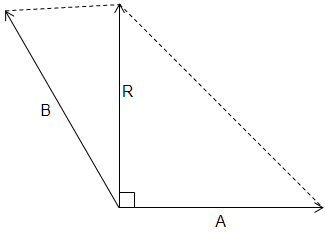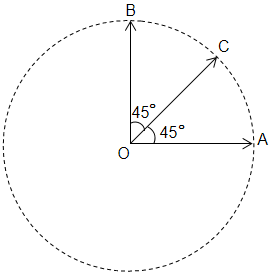A blind person after walking 10 steps in one direction, each of length 80 cm, turns randomly to the left or to the right by After walking a total of 40 steps the maximum possible displacement of the person from his starting position could be -
(1)
(2)
(3)
(4)
The resultant of two vectors A and B is perpendicular to the vector A and its magnitude is equal to half the magnitude of vector B. The angle between A and B is -

1.
2.
3.
4. None of these
The three vectors OA, OB and OC have the same magnitude R. Then the sum of these vectors have magnitude -

1.
2.
3.
4.
A truck travelling due north with 20m/s turns towards west and travels at the same speed. Then the change in velocity is -
(1) 40 m/s north-west
(2) m/s north-west
(3) 40 m/s south-west
(4) m/s south-west
1. \(2v\cos40^\circ\)
2. \(2v\sin40^\circ\)
3. \(2v\cos20^\circ\)
4. \(2v\sin20^\circ\)
What is the resultant of three coplanar forces: at , at and at ?
1.
2.
3.
4.
Two forces, and are acting on a body. One force is doubled of the other force and the resultant is equal to the greater force. Then the angle between the two forces is -
(A)
(B)
(C)
(D)
If the angle between vector a and b is an acute angle, then the difference ab is -
(1) the main diagonal of the parallelogram
(2) the minor diagonal of the parallelogram
(3) any of the above
(4) none of the above
What displacement must be added to the displacement to give a displacement of pointing in the x-direction?
(1)
(2)
(3)
(4)
A child pulls a box with a force of \(200~\text{N}\) at an angle of \(60^{\circ}\)
1. \(100~\text{N}, ~175~\text{N}\)
2. \(86.6~\text{N}, ~100~\text{N}\)
3. \(100~\text{N}, ~86.6~\text{N}\)
4. \(100~\text{N}, ~0~\text{N}\)







